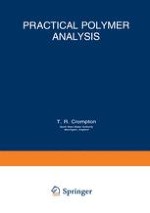1993 | OriginalPaper | Chapter
Fractionation of Polymers
Author : T. R. Crompton
Published in: Practical Polymer Analysis
Publisher: Springer US
Included in: Professional Book Archive
Activate our intelligent search to find suitable subject content or patents.
Select sections of text to find matching patents with Artificial Intelligence. powered by
Select sections of text to find additional relevant content using AI-assisted search. powered by
Polymers normally do not consist of a particular molecule with a unique molecular weight, but rather are a mixture of molecules with a molecular weight range which follows a distribution. With some types of polymers the picture is further complicated by the appearance of what are known as crosslinks. These are chemical bonds which link one polymer chain to another. Crosslinking will, therefore increase the molecular weight of a polymer and, incidentally, decrease its solubility in organic solvents. These are some of the features which make it possible to produce for a given polymer, say polypropylene, a range of grades of the polymer, each with different physical properties and end-uses and each characterized by a different molecular weight distribution curve and degree of crosslinking. The factors which control these parameters in a polymer are complex, and are linked with the details of the manufacturing process used. They will not be discussed further here. The measurement of the molecular weight is a task undertaken in its own right by polymer chemists, and is concerned with the development of new polymers and process control in the case of existing polymers. Additionally, however, it is necessary to separate a polymer not into unique molecules each with a particular molecular weight, but into a series of narrower molecular weight distribution fractions.
